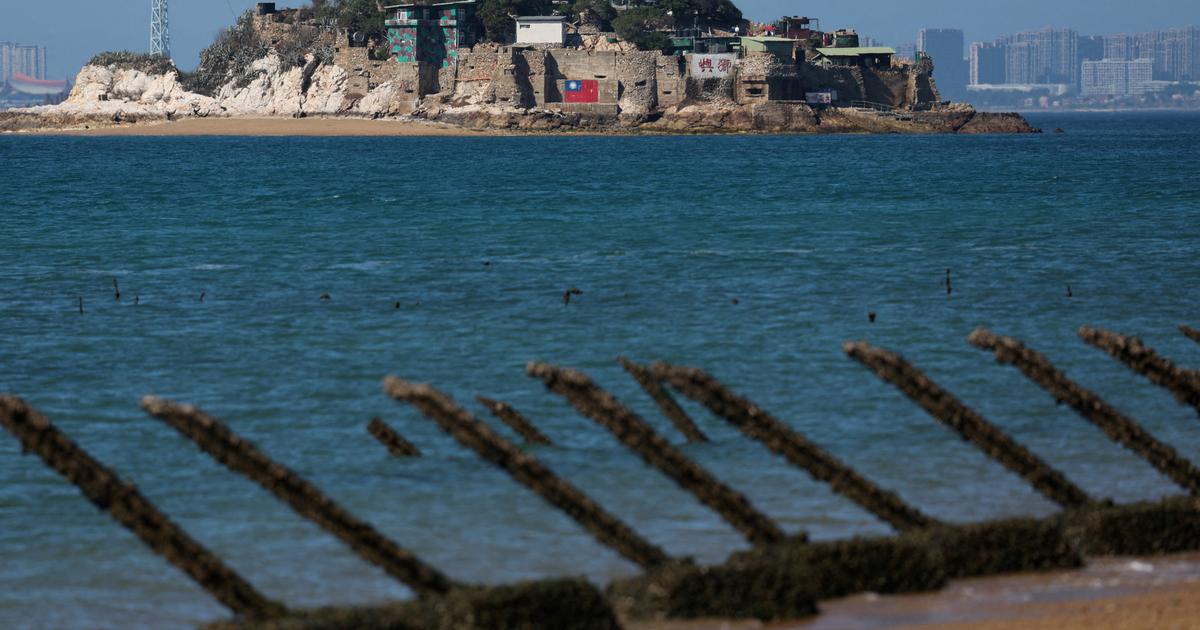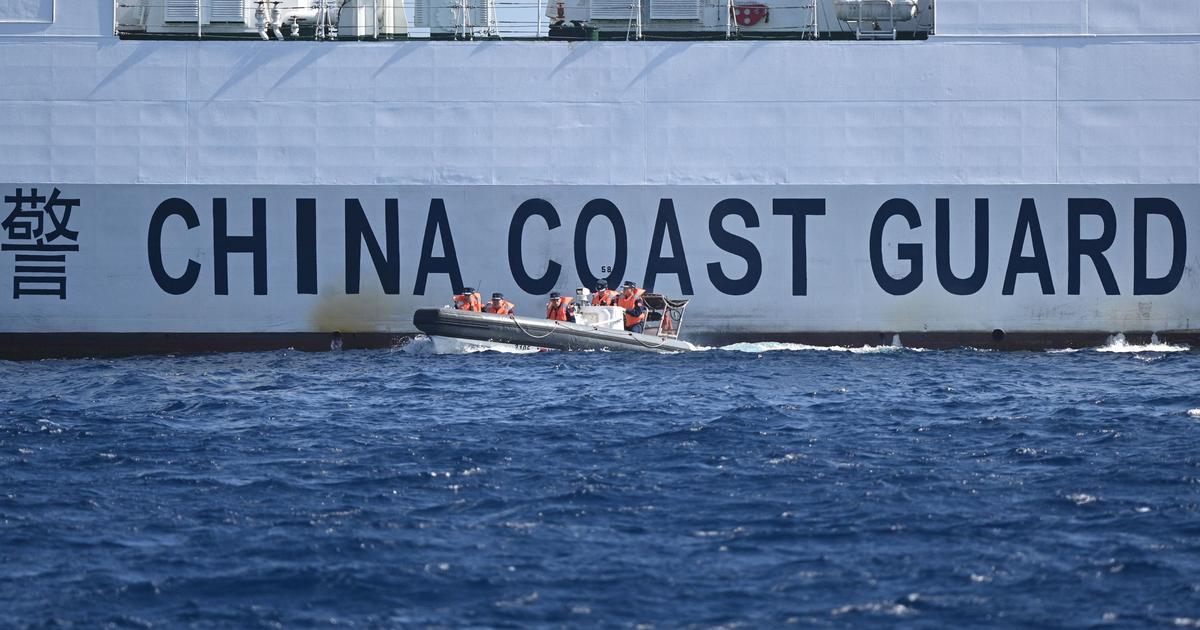Taiwan warns: China would be ready for invasion in 2025 2:51
(CNN Spanish) -
The USS Milius, a United States Navy missile destroyer of almost 9,000 tons of displacement, crossed the waters of the Taiwan Strait between the island and China on Tuesday, and once again strained the relationship between Washington and Beijing.
"The transit of the ship through the Taiwan Strait demonstrates the United States' commitment to a free and open Indo-Pacific region," they said from Washington.
A United States destroyer returned to transit through the delicate Taiwan Strait causing unrest in China
For China, on the other hand, with the navigation of the ship, the United States had "crossed the line and played with fire."
It is not the first time that US warships have sailed through China's territorial waters or disputed by Beijing.
But why do they do it and what exactly are they looking for?
America's gamble
These navigations of warships in territorial or disputed waters fall under what the United States Department of Defense calls Freedom of Navigation Operations (FONOPS).
advertising
Established as a policy in 1979, they are intended to "exercise and enforce the rights and freedoms of navigation and overflight throughout the world," according to the Department of Defense.
Specifically, they consist of making a ship make an "innocent passage" through territorial or disputed waters, generally in areas where there are "excessive maritime claims", according to the United States' considerations.
Some examples of these "excessive maritime claims", which the United States is unaware of when carrying out these operations, are: Algeria's request to give 15 days' notice before an innocent transit of a warship;
the requirement of a permit by Ecuador to carry out military exercises in its exclusive economic zone;
the requirement of prior authorization by Malaysia for the passage of nuclear powered craft in its territorial waters.
China has been very critical of these operations.
In an editorial in the state newspaper
China Daily, it
was assured that "excessive maritime claims" are actually legal under the Convention of the Sea. While the state agency Xinhua has said that "the FONOPS aim to maintain supremacy United States global maritime shipping and challenge the sovereignty of other countries and international public interests. "
What is the "innocent step" step?
Any ship, whether civil or war, can navigate without stopping through the territorial waters - that is, up to 12 nautical miles (about 22.2 kilometers) from the coast - of a State as long as this transit does not affect the peace, the order or safety.
The principle is included in the United Nations Convention on the Law of the Sea, which entered into force in 1994.
In total 158 countries signed the treaty, including almost all of Europe, Latin America, Russia and China, which is considered a pillar of international law.
China could use military force to control Taiwan 1:57
The United States is one of the few countries that has not signed it, along with Venezuela, Peru and Turkey —among others—, although Washington recognizes the right to "innocent passage" and other postulates of the UN Convention.
The United States not only conducts freedom of navigation operations off the coast of China.
According to the report made by the Department of Defense to Congress in 2020, that year FONOPS had been carried out in the territorial waters of Algeria, Argentina, Brazil, Iran, Japan and Venezuela, among many other countries.
Nor is it the only country to do so.
In 2015, Chinese warships sailed into US territorial waters, 12 miles from Alaska, and invoked "innocent passage."
In territorial waters of China or claimed by Beijing, the United States carried out seven FONOPS operations that year alone, far more than in any other country, according to the report.
The navigations of US warships in Chinese territorial waters or disputed by Beijing often elicit angry responses from Beijing, especially since the relationship between the two powers began to strain in recent years.
Recent operations
According to a report by the Center for Strategic and International Studies (CSIS), a
think tank
based in Washington, the FONOPS grew in frequency since 2015, especially aimed at counteracting China's territorial claims in the Pacific, which concentrates the main maritime trade routes in the world.
China-US tensions
by military presence in the Pacific 0:36
Many of these generated important diplomatic conflicts;
China's claims overlap with those of Brunei, Indonesia, Malaysia, the Philippines, Taiwan, and Vietnam, as reported by research from Harvard University's Belfer Center for Science and International Affairs.
In October 2015, a US destroyer sailed less than 19 kilometers, that is, within the limits of territorial waters, of the Spratly Islands, claimed by China but not recognized by Washington.
There were two other FONOPS on the same islands in 2017, and another in 2019, this time executed by two destroyers.
In February 2021 another destroyer, USS John S McCain, crossed the Taiwan Strait, the first FONOPS operation off China since the inauguration of President Joe Biden in the United States.
Nine months later, it would be the turn of the USS Milius.
China has condemned these operations, saying about the crossing in February that it "seriously violated China's sovereignty and security, seriously undermined regional peace and stability, and deliberately disturbed the good atmosphere of peace, friendship and cooperation in the Sea of South China ".
In 2020 alone, U.S. warships crossed the Taiwan Strait 13 times, according to the Seventh Fleet.
It beat the 2016 record, when they did it 12 times during the last year of the Barack Obama administration, showing that FONOPS would seem like a bipartisan policy.
The situation is part of the latent conflict between China and Taiwan, an island that the Beijing government considers part of its territory.
The formal name of China is the People's Republic of China, while the formal name of Taiwan is the Republic of China.
Both governments consider the island of Taiwan to be a Chinese province and both claim to be the legitimate rulers of all of China, including Taiwan.
The United States does not recognize Taiwan as an independent country, but it is at the same time its main ally in the region, and Biden said in October that it will protect Taiwan if China decides to attack.
US naval bases off China
Since the end of World War II, the United States has maintained a strong military presence in East Asia, especially over the Sea of Japan and the South China Sea, through its naval bases in Japan.
According to official information from the Navy, the United States has 12 warships at its base in Yokosuka, including 8 destroyers, 3 cruisers and an auxiliary ship.
While at the base in Sasebo there are another 9 ships assigned, including an amphibious assault ship, 2 landing ships, 2 transport ships and 4 minesweepers.
To this strong permanent presence is added the recurrent patrolling of nuclear-powered aircraft carriers and submarines, based in bases in Pearl Harbor and the US west coast.
ChinaUnited StatesTaiwan





/cloudfront-eu-central-1.images.arcpublishing.com/prisa/OORXB2YNDLANHK3OYLEUMD7SPM.jpg)







